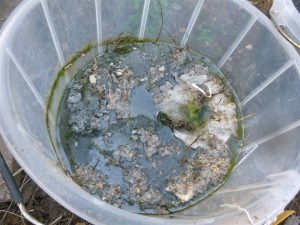Horsetail, commonly referred to as Marestail, is a resilient and ubiquitous plant often found thriving in allotments, and on neglected patches of land.

Characterised by its thick, silica-rich outer layer and small needle-like leaves, this perennial weed emerges in the UK with distinctive light brown stems that can grow between 20 to 50 cm (10-20 inches) before developing into taller, fir tree-like structures that may reach up to 60 cm (2 feet). While many gardeners consider horsetail a nuisance due to its invasive nature, it also holds the potential for beneficial use, particularly in organic gardening practices.
One effective method of utilising horsetail is by creating a liquid feed through a process often referred to as “drowning.” This involves submerging the horsetail plants in a lidded bucket or water butt to extract their nutrients. Due to their high silica content, horsetail tea is renowned for its ability to enhance the overall health of treated plants, acting as a natural fungicide that helps protect against common garden ailments such as blackspot, mildew, and mint rust. To ensure proper fermentation, it is essential to keep the horsetail fully submerged, which can easily be achieved by placing it in a sack or old vegetable net weighed down with stones. Regular stirring during the fermentation process—lasting anywhere from 10 days to 3 weeks, depending on the warmth of the environment—can help fortify the nutrient content of the tea. As fermentation progresses, the mixture will produce gas and bubbles, and once the bubbling ceases, the liquid can be strained and used to nourish other plants, turning what many see as an unwanted weed into a valuable resource for the garden.
Moreover, the leftover sludge from the process can be a fantastic addition to compost bins, enriching the organic matter and boosting microbial activity. In this way, horsetail not only provides a sustainable way to manage garden health but also encourages a more eco-friendly approach to gardening. Embracing the challenge of horsetail may lead not just to better garden management, but also to an enriched understanding of the interconnectedness of plants and their uses.

Fresh Horsetail soaking.

Horsetail after soaking for 13 weeks

Close up of the horsetail after 13 weeks soaking

4 months soaking

6 months soaking


